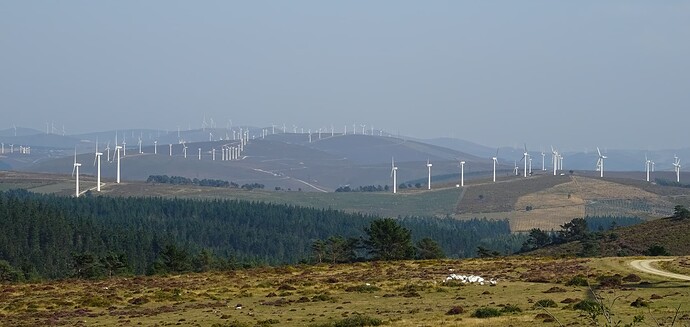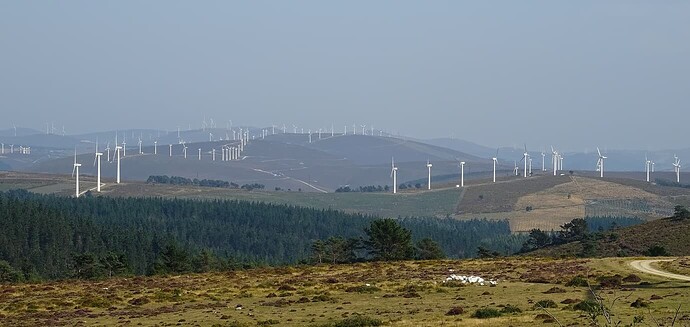They are awful eyesores, not good for birds, make a noise, are being constructed too close to habitations. Apparently in 2006 the WHO considered it prudent to define a minimum wind-home distance of 1500 meters. This was retained by the Academy of Medicine in France. But the Sarkozy-Fillon government decided on 500 meters. I read that the Senat voted to increase the distance to 1000m, so there is that! I was shocked to see so many of them in Spain. But I guess there are very few people living on the windy heights of Galicia.
Andalucia was where I first encountered them in large numbers. They just destroyed what would have been a spectacular landscape, though at least there were very few living near them, as you say.
Probably down to the videos on the internet of turbines or blades that catch fire, and then fall or get flung off onto the ground - I can imagine that no one would be particularly happy about a flaming wind turbine part setting fire to the Medocan scrub.
I have a love/hate relationship with them. Historically, there were plenty of windmills in pretty much every country until they were replaced by industrial engines. Obviously, these windmills dotted the land, but were of much smaller size than the current wind turbines. So from the aesthetic aspect, I’m not too bothered, although I wouldn’t personally want to live near any - they are fairly noisy close-up. From an engineering standpoint, I think they are a marvel of the modern world, and improving all the time, although I’m not entirely convinced about their long term environmental impact with regard to recycling - they literally leave a fairly large carbon footprint during manufacture, and even today, recycling the constituent parts at end of life seems to be more of a pipe dream at the moment. Some would argue that the carbon footprint is significantly lower than a concrete nuclear power station, but the power outputs aren’t the same, and the life expectancy of a wind turbine is presumably quite a bit lower than a nuclear power station. That being said, would I rather have to dispose of a wind turbine, or the remains of a nuclear power station…hmm, given the half lives of tainted materials produced in a nuclear power station, I think I’d rather go for the turbines, providing we don’t just dump the remains in huge holes in the ground, as we seem wont to do.
It depends on the weather. White can make them completely unobtrusive in clear conditions whereas green would look unnatural and stand out against the sky. White also apparently keeps them cooler.
Individual phone masts can be disguised to blend in, but these turbines are too big for that.
Slight “side bar” point…
When a wind turbine reaches the end of it’s life & is not replaced then the (relatively small) site it inhabited can be returned to a natural state. Yes, there’s lots of concrete to break up, but you get my point.
My point is that when/if wind power is superseded we can quickly repair the small damage they caused.
That cannot be said of nuclear power stations & their attendant waste products.
In the Noughties I did several years’ academic research on windfarms’ impact on landscape aesthetics (one of my main research areas) and looking at some of the posts above it seems as there’s as much misinformation circulating now as there was fifteen years ago, that it’s difficult to address all the points succinctly. But I’ll try!
Noise: large wind turbines are not noisy. I’ve stood directly underneath many and made audio recordings of them; there is a woosh sound as a vane passes immediately over your head. I’ve also got many photos of unconcerned cows and sheep grazing right up against the towers.
Visual impact: campaigners against windfarms tend to use misleading images of black turbines against red or orange skies, but the human eye never sees that, even if viewed against a setting sun.
OTOH many professional photographers’ web sites have portfolios studies of these new rural landscapes.
On land a windfarm can activate an otherwise boring treeless landscape that consists of nothing but large hedgeless fields such as one sees in many parts of northern France.
Marine windfarms I lived opposite a sixty turbine marine windfarm on the Solway Firth for years and loved the way the turbines continually changed with the light and weather just as clouds do. My wife did around sixty paintings of this spectacular marine vista, as I’m sure Turner would have if he was still around.
Marine windfarms actually protect the sea bed because fishing boats avoid them and they actually encourage regeneration, particularly in areas where the sea bed has been damaged by activities like scallop dredging.
All technology is intermediate and I suspect terrestial windfarms will over time be superceded by deepwater ones, many of which will be out of sight of land.
Birds: Most ornitholgists fears about their impact on migration routes have now been allayed : some species actually fly between the turbines, others fly over them.
At the end of their useful life, they’re easily dismantled and most recent designs can be completely recycled.
Lastly, has any one else on SF ever been to Sellafield, if you haven’t there’s plenty of time, it’s being redesigned - to last for centuries?
That I disagree with. I have stood near them and found the sound quite unpleasant. And from further away a rather irritating quite high pitched background hum - somewhat similar to our neighbour’s milking parlour, but that only operates a few hours a day. The cows aren’t bothered of course but perhaps neither they nor sheep find background noise invasive?
I wish they would paint the tips of the fans, only a modest extra cost but apparently reduces bird strikes significantly.
Most of the noise comes from the blade moving through the air I think, and not the generator or rotor hub. So, it is probably down to friction, between the air and the blade.
Logically at ground level you are a lot closer to the blade tips than you are to the hub/generator.
Supposedly blade tip speeds can be over 100mph.
So if you live in a house close to one and it is as tall as the hub, live upstairs. ![]()
I would expect if that happened, it was the fault of the turbine operators, or maybe the failure of some automatic system. If the wind speed goes above a certain pre determined speed, the turbine blades should be ‘feathered’, which involves turning the blade so that the leading edge points straight into the wind, stopping it turning. A brake should also be applied. If this isn’t done, the blades will probably break, destroying the pylon and generator in the process.
I went there early 90s, one of those days you would have drowned trying to do any lake district climbing. Was interesting and informative
Is Sellafield very different from Dungeness, that I visited in the 1970s as a teen?
Calder Hall had an output of 200MWe and windscale 30MWe (Sellafield - Wikipedia). Apparently a typical land-based wind turbine can produce 2.5-3MW Wind energy frequently asked questions (FAQ) | EWEA
I read somewhere quite some years ago that painting one of the three blades black, while leaving the others white, not only reduces bird strikes but also bat deaths, which are dreadfully high. Seems Norway conducted a lengthy trial on coastal turbines in 2020 with very positive results.
In the US a trial has begun
Seems the industry knows but is glacially slow to react
I don’t know why, even if it only works a bit, that all turbines shouldn’t have one black blade. ASAP.
Sad, in France not far from me
Sorry, but I’ve never seen them as completely unobtrusive, and in the picture above they stand out like sore thumbs. How about a less gleaming white, a matt off-white, so they don’t reflect the light?
Does anyone know what is better, wind farms or tidal generators?
Tidal is clearly more predictable, but is a much bigger engineering challenge (i.e. cost) than land based éoliennes.
Tidal barrages are deeply unpopular due to their effect on the status quo of an estuary or wherever. They’re also very costly.
Using tides to flow through floating generators is good in terms of aesthetics & probably comparable with sea-based wind turbines in terms of seabed issues.
Land based stuff will always be cheaper & quicker to install/maintain than going out to sea.
The two technologies are at differing stages of development and uptake, so direct comparison is complicated. I think in many countries with a seaboard marine and the newer, larger deep water wind farms will replace many terrestrial ones because the can be much larger and their location is less controversial.
As @Badger has explained there’s a broader range of methods of tidal power generation. Barrages’ high visibility and possible impact on the marine environment are arguments against but they can also connect currently separated communities eg across Morecambe Bay, to connect the Lancashire coast with Barrow in Fand the Wester Lakes.
Solar has been mentioned too, but again it need not be an either or situation. Instead it surely horses for courses. For instance, Morocco encourages both forms of generation and has for several years exported considerable amount of solar generated energy to Spain.
What is happening with the French plan to cover car parks with solar panels?

